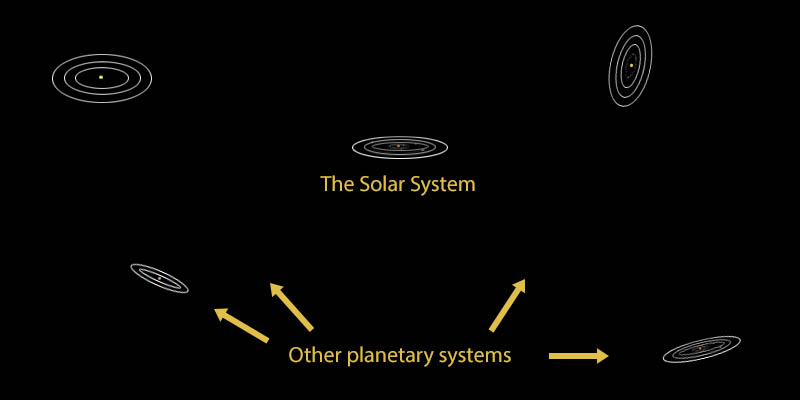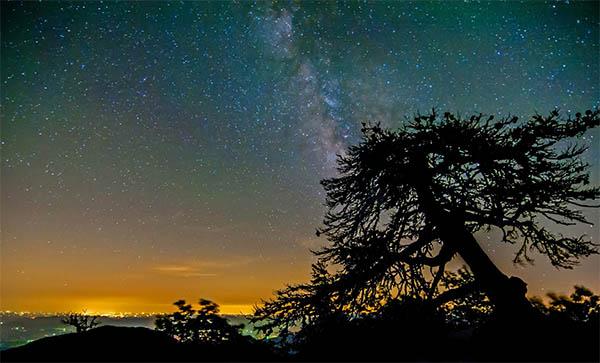The Structure of the Universe
(How to understand the Universe in 10 minutes)
This page covers what I think is the most important thing to understand about space: The basic structure of the Universe. It's a long page but it's not actually very difficult. If you can understand everything on this page, you'll understand more about the Universe than most people.
Before we start there are a few things you need to know:
- The Sun is a star, similar to all the other stars you see in the night sky. There are different types of stars, some smaller than the Sun and some much larger.
- Celestial objects (e.g. star, planets, moons) tend to rotate on their axis like a spinning top. Earth does it, the Moon does it and even the Sun does it.
- Celestial objects tend to orbit (travel around) other celestial objects. Smaller objects orbit larger (more massive) objects. Many objects can orbit the same object. One object can orbit another object which in turn is orbiting an even more massive object (and so on).
Now, let's begin...
We live on a planet.
It's called Earth. Like all planets it's roughly spherical in shape. Earth rotates on its axis and we call the time it takes to complete one rotation a day.
Earth has one moon, called The Moon. The Moon orbits around the Earth once every 27.32 days. We approximate this orbital period into units of time we call months (month = moonth).

When you have a celestial object with at least one other thing orbiting it, you can call that whole thing a system. The Earth and Moon together, along with any other objects orbiting Earth, can be called the Earth system (or sometimes the Earth/Moon system). The Earth system travels as one unit through space.
The Earth system orbits around the Sun. It takes 365.25 days to orbit the Sun and we call that a year.
There are eight major planets (that we know of) and many smaller objects orbiting the Sun. The Sun and everything that orbits it make up the Solar System, i.e. the system that is centered around the Sun (solar system = sun system). This means that...
Our planet is part of the Solar System.

All the planets orbit anti-clockwise as seen from "above" the Solar System (i.e. above Earth's North Pole). All planets orbit in roughly the same plane, forming an overall disc shape.
Mercury and Venus orbit alone with no moons. Earth has one moon, Mars has two and the outer gas giant planets all have lots of moons.
There are also countless smaller objects orbiting the Sun including Pluto, other dwarf planets, asteroids, meteoroids and comets.
REMEMBER: The Solar System consists of the Sun and everything that orbits around the Sun.
We call it the Solar System as if it's the only one but in fact it's not. Far out in deep space there are billions more "solar systems". Astronomers call them planetary systems, i.e. a set of planets orbiting a star.

You can actually see other planetary systems (sort of) because when you look at stars in the night sky you're looking at other "suns". Most of those stars have their own families of planets orbiting them, just like our star has its family of eight planets. You can't see the planets in other systems because they're too small and faint, but you can see their suns.
On a clear night you can see several thousand stars/planetary systems. Some are young, many are middle-aged and some are old.

Most of the stars in this photo are suns of other planetary systems.
Planetary systems are basic building blocks of the Universe. Each star and its family of planets is a unit that is born together, lives and eventually dies together (when a star dies it's pretty much a death sentence for anything orbiting it).
Almost everything you can see in the sky is far outside our Solar System, but in the big scheme of things it's still relatively local. Along with the Solar System, all the individual stars and planetary systems you can see are part of a bigger structure...
The Solar System is part of the Milky Way Galaxy.
The Solar System and all the neighbouring planetary systems are part of a galaxy we call the Milky Way. This galaxy is made up of an estimated 200 billion stars, most of which have planetary systems. Remember that you can only see a few thousand of these stars with your own eyes so you're only looking at a very small part of the Milky Way.
The Milky Way is shaped like a disc with a bright bulge in the middle surrounding the galactic centre. The bulge is caused by a higher density of stars near the middle of the disc.
The images below show the galaxy from "above" and on its side. Our entire Solar System is a tiny dot at this scale.

Everything in the Milky Way, including our Solar System, is orbiting around the galactic centre. At the very centre of the galaxy lies a super-massive black hole. This black hole is to the galaxy what the Sun is to our Solar System. In other words the Earth is orbiting a star that is orbiting a black hole1. It takes our Solar System about 250 million years to orbit the galactic centre once. The last time we were at our current position in the galaxy, dinosaurs had not yet evolved.
REMEMBER: The Moon orbits Earth, which orbits the Sun, which orbits the galactic centre.
We're almost there but there's one last big jump in scale to make...
The Milky Way Galaxy is part of the Universe.
The Milky Way is one of at least 100 billion galaxies in the known Universe. Each galaxy is made of billions of stars and planetary systems.
The Milky Way, a fairly typical galaxy, is surrounded by a number of dwarf galaxies that appear to orbit our galaxy. The closest similar galaxy to ours is Andromeda, about 2.5 million light-years away and also surrounded by dwarf galaxies. The galaxies shown below, along with a few others, make up a set of galaxies called the Local Group.

At this scale galaxies can be moving in any direction relative to each other. In our case the Andromeda galaxy happens to be on a collision course with the Milky Way. Don't worry, it's not your problem.
As the name "Local Group" implies, these are just a few of the closest galaxies to us. The entire Universe is unimaginably larger and may indeed be infinitely big (we don't really know). The image below shows a much larger section of the Universe in which the Local Group is a tiny dot in the middle (part of the "Virgo Cluster"). Each tiny white dot represents a group of galaxies.
At this point you start seeing the large-scale structure of the Universe in which clusters and super-clusters of galaxies are arranged in a pattern of filament structures. This is pretty much how the Universe looks as far into the distance as we can see.
At this scale there is also a distinct pattern of motion. It appears that, with some local exceptions, all galaxies tend to be moving away from all other galaxies. In other words, the Universe appears to be expanding. This was the first clue that eventually led to the Big Bang theory, but that's another story.
We'll finish with one last image... the visible Universe. This isn't the entire Universe because we can't see that far but we assume there's more of the same beyond. This raises questions about how big it all is, what it's expanding into, etc. Sorry but those questions will have to wait for another tutorial (spoiler: we don't really know).
So that's it. Ideally you should be able to pass the following tests but don't worry if you can't or if it doesn't come naturally. Most people find that it takes time to master this stuff, but most people also find that it's worth it.
Test yourself
- You should be able to answer the following question confidently: "What's the difference between the Solar System, the Milky Way galaxy and the Universe?"
- You should be able to imagine each of the following objects in their correct orbits relative to each other: Moons, planets, stars, galactic centres.
- If you see a news story about astronomy, you should be able to visualize where in the Universe the story is set. Is it somewhere "local" in the Solar System, outside the Solar System but within our galaxy, or is it far across the Universe?
Previous: Measurement Units | Next: Sizes of things in space
1. Technically it's not the black hole we're orbiting, it's the barycenter of the Milky Way, or the centre of the combined mass of the galaxy. However for simplicty's sake it's okay to think of everything in the galaxy orbiting the black hole.


